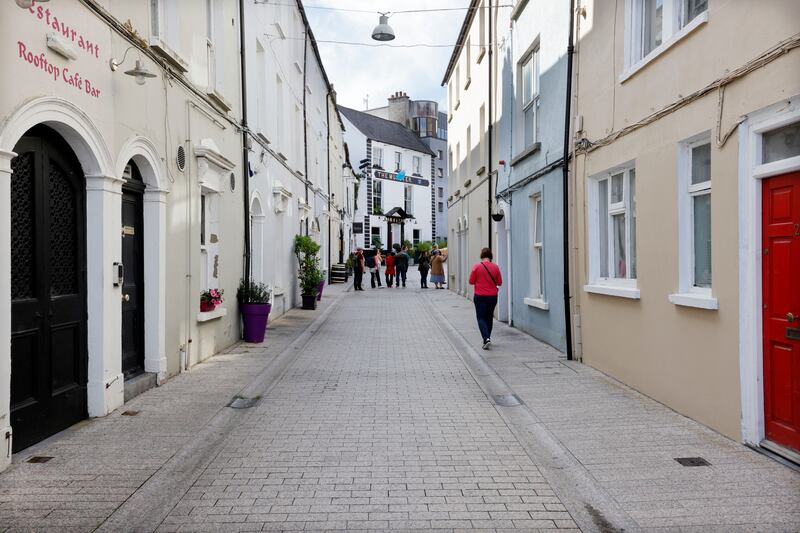In the past nine months I must have walked past Harbour Court lane more than 200 times. I have never walked through it, for reasons that will be obvious to anyone else whose commute takes them in its rough vicinity. It is a street you smell before you see, the putrid stench of ammonia is its calling card.
The improbably named laneway isn’t just a long-standing landmark on Dublin’s “wild toileting” scene. As was widely publicised following a decision by Dublin City Council last week to shut it down, it is also rife with open drug dealing, dumping, violence, theft and the sex trade. Last September a man was hospitalised with “non life-threatening injuries” following an alleged assault there.
On a cool December morning recently, I got off the Luas and walked behind two gardaí who were heading along Abbey Street away from the direction of Harbour Court. It was a moment before I noticed one was carrying a knife in his left hand, an evidence bag wrapped around the handle, its long blade pointed towards the pavement.
[ Dublin’s unloved lanes: are street closures the solution to antisocial problems?Opens in new window ]
In 1842, according to the Dublin Almanac for that year, the signs along Harbour Court would have advertised the businesses of Alexander McCrea, an umbrella manufacturer; Mr Reynolds, a professor of dancing; and William Valentine’s Italian warehouse. In more recent times, the notices read: “please do not PEE or POOP in this zone. Max fine €500.”
The street’s decline didn’t happen in the manner of a sudden loss of cabin pressure so much as a slow, inexorable descent over many years. “Colloquially known as ‘Piss Alley’, this place is frequented by shady-looking characters and hurrying, disgusted-looking tourists,” goes a Yelp review from 2009.
According to Dublin City Council the best remaining solution – having exhausted literally no other options – is to shut it down. Business owners in the area seem to be unanimous in their approval. You can hardly blame them. They don’t have the resources or the expertise to wrest it back from decay. But designating areas of the capital city no-go areas cannot be the strategy. The decision amounts to a shrug from official Ireland, too busy going about its business on the other side of the river to care.
Inner-city Dublin is no different from other big cities grappling with the problems of addiction, crime, homelessness, dereliction, litter. But Harbour Court isn’t the cause of these problems; it is just one particularly visible, highly malodorous manifestation of them. Shut it down, and you don’t solve anything: you just shunt the issues along to the next dank city lane or underused park. Is there a plan for what happens then, beyond locking up parts of the city?
As a measure of assessing the state of Dublin “marginally less reported violent crime than last year” is a depressingly low bar
At this juncture in the discussion, politicians and the gardaí will typically point to the data; the statistics show that violent attacks in Dublin have not increased. Dublin city centre is safer than other European cities, Garda Commissioner Drew Harris told The Irish Times recently. “We’ve had very serious incidents, nobody denies that. But is that the same as lawlessness?”
But repeating the message that people are safe – or at least at no more risk than they were in 2019 – is not an effective strategy when they don’t feel safe. As economist Paul Krugman says, “perceptions about crime are like perceptions about the economy – perhaps more so: They don’t necessarily bear much relationship to reality.”
As a measure of assessing the state of Dublin “marginally less reported violent crime than last year” is a depressingly low bar. Not when a walk through the city offers evidence of visible drug use; when so many streets away from the main thoroughfares, especially in the north inner city, are filthy and neglected, and sticky underfoot; where the sour odour of urine and the detritus of drug use visible alongside the piled takeaway cartons. This is how people form their impressions, not the reported crime data.
Councillors pointed to London’s Islington as an example of an area that had been turned around. But you don’t have to look that far.

My commute past Harbour Court begins and ends in another city that, not very long ago, also felt like a place that had given up on itself. These days, though it still has plenty of problems, Waterford is in the unfamiliar state of having a better story to tell. It is doing well on metrics both real and invented. The New York Times designating it one of the top 52 places to visit this week won’t matter much to the people who live there; things like having an emergency department that functions, streets that are generally clean of litter and a city centre that feels safe and well managed do.
Talk to people in Waterford about how it got back on its feet and there is no quick fix. It seems to come down to a decision on the part of city management, business owners, the arts community and local politicians in about 2007 that the slide could not be allowed to continue and a vision for what they wanted the city to be. Waterford’s Viking Triangle and, more recently, O’Connell Street are good examples of what “vision” looks like at street level. The Viking Triangle was once an unloved warren of dark back streets; last year, it drew more than 100,000 visitors to its six museums. O’Connell Street is now the hub of a planned new cultural quarter. Does Dublin have a similar vision for itself, other than being the tech capital of Europe?
Harbour Court doesn’t sit neatly alongside the gleaming glass boxes on the dockside, so the instinct is to do what we’ve always done with things that don’t fit the stories we want to tell: lock it away. But closing a street is not a solution; it is a symptom of a city giving up on itself.










